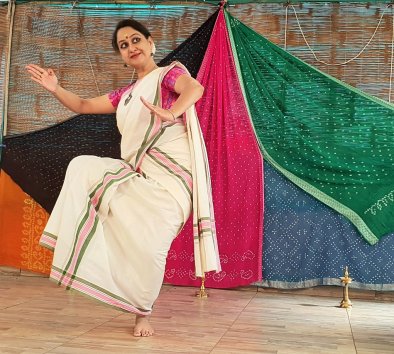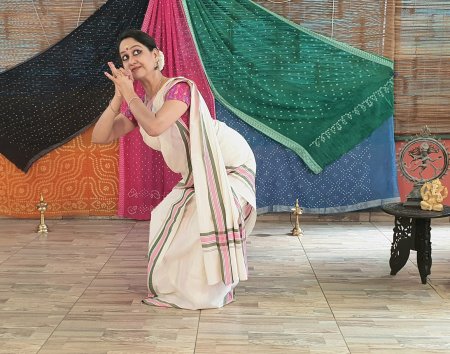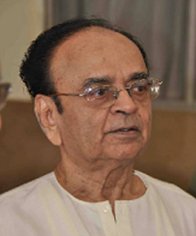
|   |

|   |
Mohiniattam explores Kavi Kalidasa - Dr. S D Desai e-mail: sureshmrudula@gmail.com December 28, 2020 Virtual classical dance performances on Webinar, particularly as part of lec-dems in the current extraordinary situation, afford viewers, even those uninitiated, an advantage. They get to understand the basics of a dance form, its subtleties and nuances through the close-ups of abhinaya and a slow-paced verbal communication the dancer thoughtfully makes. This advantage came to mind when Ayswaria Wariar's two-day (Dec 17 & 18, 2020) around a hundred minutes long each event 'Exploring Kalidasa through Mohiniattam' was held by The Oriental Institute, M S University, Vadodara, with Dr Rabindrakumar Panda, a Sanskrit and Pali scholar in the chair. There have been over the last eight months quite a few outstanding dance events, not to mention innumerable ordinary ones, curated by the country's most eminent classical dancers and dance centres. It would have been pretty difficult to comprehensively write about them all. I choose to resume writing here to highlight the advantage the viewer gets through a virtual dance performance. There have certainly been other dance events in the comparable format which, also for personal reasons, I could not respond to earlier. A dance researcher besides being a dancer, Ayswaria insightfully explained and demonstrated integration of the aesthetics of the text (here Kalidasa's Abhigyana Shakuntalam and Meghadootam), dance (here suggestion-rich, lasya governed Mohiniattam) and music (here Kavalam Narayana Panicker's with NN Sivaprasad's). Both, Shakuntalam, a dramatic work, and Meghadootam, a mini epic with a narrative, have earlier been performed by her in a group. She now performed excerpts from them in ekaharya abhinaya.  Though living far away from the land of its origin, Mohiniattam, she significantly observed, "has grown into me." It had been "a tool of communication" for her, she said. The gracefully feminine movement, circular and unbroken, is with the torso. The abhinaya is with select hasta mudras and the intricate expression of emotions is on the face, particularly with the eyes. The feet gently stamp, denoting the ascending and descending tempo of the taala. Not attired in the traditional aharya of the form, in her power-point presentation she introduced its chief components - hair tied on the left has a white ring of jasmine flowers; the colour of the sari has a combination of off-white and gold. She did well to point out that the jewellery the dancer wears is of genuine gold and that eye makeup is required in Kerala's all performing art forms, developed from a theatrical tradition. Ayswaria is blessed with the musical genius of no less a person than K N Panicker for Meghadootam. His Sopanam music has infused in it elements of the Carnatic classical, both vocal and instrumental, Kerala's indigenous enchanting sounds drawn from nature and those of folk ritualistic traditions of the land. The composite outcome has a special flavour that blends with the ambience Kalidasa has very sensitively and subtly created in his work. For Shakuntalam, music is pleasingly composed by N N Sivaprasad. In her ekaharya on Shakuntalam, the dancer-choreographer skillfully takes off at the crucial dramatic time when King Dushyanta refuses at his palace to recognize and accept Shakuntala, carrying his child. Ayswaria here takes a psychologically valid liberty with the text. She has her Nayika call out Mother Earth. A refreshing magical flashback unfolds on Kanva's ashram, where her intricate mudras now conjure up beautiful flowers and a deer in playful abandon and animated plants that do not let go of Shakuntala. A flashback within the flashback has hasta mudras and the mukhaja and netra abhinaya portraying the pleasing Greeshma time rich in sensory perceptions of sight, touch and smell. subhagasalilaavgahah (plunging in cool waters pleases) paatalasansargsurbhivanavaataah (fragrant are the breezes with the touch of Paatal flowers). The Nati's shloka before the play in the beginning with its lyrical verbal beauty gets visualized by the dancer with repeated intricate Mohiniattam mudras, like a vocalist's spellbinding variations, to the accompanying complementing sangeetam, in which the veena adds to the charming lasya. All in less than five minutes. That's how poetry, drama, dance and music are blended in the celebrated Sanskrit dramatic tradition. The Nati's next shloka is depicted without its recitation. The eight-minute presentation, done with an aesthetic sense, must have greatly pleased the participating invisible Sanskrit scholars. The satisfaction was seen writ on the dancer's face when she addressed them. With King Dushyant now enters the theatrical aspect of the composition. The dancer-choreographer takes the opportunity to point out how in an ekaharya, the character changes with minimalistic changes in the presentation. The dancer turns her back to the viewers and within a moment faces them transformed as the leading male character, the King, his stance erect and action close to veera rasa, a dramatic contrast to the shaanta rasa that the Nati had ushered in with music. The king following the deer becomes a symbol of his near infatuation with the innocent ashram girl Shakuntala.  Just as the prose in addition to poetry in Shakuntalam on Day One was rich with suggestion and lyricism, the verse lines of Meghadootam on Day Two had the unique richness of poetic connotation and a flowing depiction with luxuriant imagery besides an intense expression of the Yaksha's viraha from his wife. With her easy felicity of expression through Mohiniattam, Ayswaria emerges as a performing artiste having a rich sensibility and skills of expression and at the same time, while she talks, as a good teacher with her verbal communication, modesty and a rapport with the viewers treated as learners. She has the presence of mind to highlight the finer aspects of the text, the music and the dance form with images from her earlier group performances of both the play and the epic. The Yaksha in one such image is in a brilliant dance posture with a white blouse without the feminine pallu, a sash around the neck, the body in a masculine stance unbent and with male expression. During her interaction on Shakuntala, the dancer had recalled how the girl brought up by the sage Kanva flies into a rage and dares call the King anarya. The rhythmic variations in music, the dancer brings to the notice of the rasikas, follow the meter in the text. She explains the terms Natyadharmi and Lokadharami, incidentally. The former is highly stylized and suggestive - with intricate hand gestures and body posture - as per the tenets of Natyashastra which are followed by other classical dance forms as well. The flowers Shakuntala picks, King Dushyanta aiming an arrow from his bow or the cloud the Yaksha addresses are only symbolically suggested. The Lokadharami presentation, for which she gave the example of films, is realistic. You see the objects and behaviour relevant to the context. There is a reference to varying rasas like Shringara, Vipralambha Shringara, Shaanta and Veera and to aangika, vaachika, ahaarya and saattvika abhinaya from time to time. A special mention must be made however of how, as she pointed out, Mohiniattam is a suitable medium of expression for the finer touches of beauty Kalidasa has woven into the text. It will be easy to recognize Alaka Nagari on reaching it, the Yaksha tells the Megha. Her fine garment in the form of the river Ganga is sliding down and he will notice Alaka bashfully crouched on the lap of her lover Mount Kailasa!  Dr. S.D. Desai, an author and a contributor to dance, drama and literary journals, is a freelance art writer. |